Clint stars with DNA
Milestones
Price of biosafety
Change of address
High stakes for children, nurses
No more standing room only
Fighting Parkinson's with origami

Researchers hope the comparative analysis will help explain why some diseases, such as Alzheimer's and malaria, affect people and chimpanzees differently.

Clint stars with DNA
He's tall, dark, and handsome, with a grin that turns heads, especially those of older women. Smart, playful, and a flirt, he's happiest when someone's scratching his back.
Clint, a 24-year-old chimpanzee who was born and raised at the Yerkes National Primate Research Center, is about to become famous, but not for his engaging personality.
After analyzing a blood sample, an international team of scientists chose Clint's DNA last year to use to sequence the chimpanzee genome. Because chimpanzees are the most closely related species to humans (the chimp genome is 99.4% identical to the human genome), results from the chimpanzee DNA sequencing, once compared with the human genome sequencing, are expected to reveal information impossible to obtain from comparing the human genome with the genomes of other animals. For example, researchers hope the comparative analysis will help explain why some diseases, such as Alzheimer's and malaria, affect people and chimpanzees differently.
The team, led by researchers at the Broad Institute (MIT/Harvard), Washington University, and the University of Washington in Seattle, is now comparing the chimp and human genome sequences. The scientists plan to begin publishing the results of the analysis later this year.
When not involved in studies regarding cognition, learning and memory, and behavioral training, Clint's favorite pastime is making faces and playing games, says Yerkes chief veterinarian Elizabeth Strobert. Though he's been distracted lately by his current flame, Boka, his "terrific personality makes him a favorite at Yerkes," Strobert says. "Even before his role in the genome sequencing, he was a star in our eyes."
Milestones

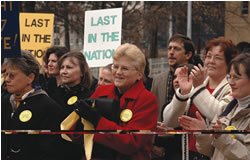
"The only state that cannot write, we want the right to write," chanted more than 100 nurses from Emory and across the state. They came to the state capitol to support Senate Bill 376, which would have given nurses authority to write prescriptions for patients via a collaborative practice agreement with authorized physicians. The measure, which did not seek authority to write prescriptions independently, was tabled on the Senate floor. Georgia is the only state in the nation that does not grant prescriptive authority to nurses.

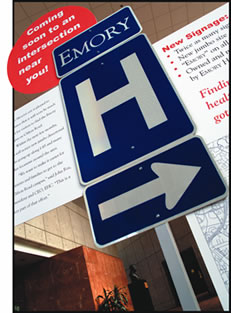

Partnership to combat bioterrorism
The Southeastern Center for Emerging Biologic Threats received a new one-year federal grant of nearly $1 million to combat emerging infectious diseases and potential biologic threats through strong regional partnerships in medicine, public health, and emergency preparedness.
Developing drugs for depression
A team of scientists from the School of Medicine, GlaxoSmithKline, and the National Institute of Mental Health received a five-year, $4.9 million grant to speed the development of drugs to treat depression and other mood disorders.
Boost for liver transplantation
Wachovia Bank, the trustee of the Carlos and Marguerite Mason Trust, awarded $2 million to Emory and Children's Healthcare of Atlanta to help insure access to care for all Georgians in need of liver transplantation. The award will create the Carlos and Marguerite Mason Chair for Liver Transplantation.
Wash away cholesterol
The Emory Heart Center, working in conjunction with the Plasmapheresis Center at Emory University Hospital, is the first site in Georgia to offer a new treatment, LDL-C apheresis. It can "wash" so-called bad cholesterol (low-density lipoprotein or LDL) out of the plasma of people at high risk for atherosclerotic disease complications due to elevated cholesterol.
High marks for teaching
Hospitalists and general internists are highly effective teachers on hospital wards, according to a study published in the Journal of General Internal Medicine. "Hospitalists typically are more available during the day to provide patient care and supervise the ward team," says co-author Sunil Kripalani, an Emory hospitalist at Grady Hospital. "This increased contact provides an important opportunity to teach and mentor medical students."
Hospitalists are physicians who primarily focus on caring for hospitalized patients. Emory's hospitalist program was established at Grady (the site of the study) in 1998 by study co-author Mark Williams, director of Emory's hospital medicine unit. It was the first such program at a public teaching hospital in the United States. Today, Emory has the largest academic hospitalist program in the nation, with 35 hospitalists at seven Atlanta-area hospitals.

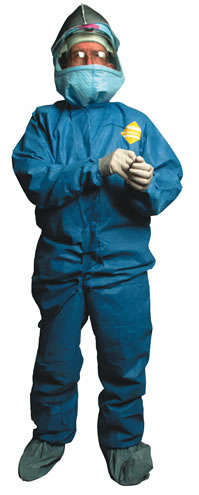

Did you know?
Emory's joint program in biomedical engineering, launched in cooperation with Georgia Tech in 1997, moved up four spots to rank second in the nation in US News & World Report's most recent ranking of graduate and professional schools.
Price of biosafety
Imagine paying $30 each time you enter your office. It's a small price for the safety and security measures surrounding the research programs at the new animal biosafety level 3 housing (ABSL-3) facility at the Yerkes National Primate Research Center.
The attacks of Sept. 11, 2001, lethal anthrax mailings a month later, and the recent SARS pandemic have brought to light the global threat of bioterrorism and the need to increase research for vaccines and treatments related to disease threats. The new ABSL-3 facility, which will cost the center at least $30 each time an employee enters the facility, places Yerkes at the forefront of the battle against bioterrorism and new and emerging infectious diseases.
ABSL-3 facilities are used for research on indigenous or exotic agents that, if airborne, could cause serious or potentially lethal diseases. While there are several such facilities funded by federal biodefense initiatives in the country, the Yerkes lab is among a select group that house nonhuman primates.
Research programs on tap for Yerkes' new facility include SARS, monkeypox, and HIV/AIDS. While monkeypox and HIV/AIDS are not considered level 3 agents (those that are transmitted through the respiratory tract and that can cause serious or deadly disease), they do pose a serious risk when present in large or virulent quantities. That's why animals in these research programs will be housed in the ABSL-3 facility.
"Any employee working in the facility has been trained on the potential hazards associated with the work involved, the necessary precautions to avoid exposures, and the proper personal protective equipment (PPE) to wear," says Maureen Thompson, Yerkes' chief environmental health and safety officer. The PPE includes disposable uniforms, double gloves, shoe covers, and a positive air-purifying respirator, all of which employees must discard before exiting the facility each time. Due to the tight level of security needed, in addition to the high cost of the PPE, only a select group of employees who have demonstrated the highest level of safety protocol awareness will work in the facility.
"The fight against bioterrorism is just one component of the Yerkes Research Center's commitment to research," adds Stuart Zola, the center's director. "Work with nonhuman primates has led to a better understanding of many diseases and to the development of treatments for them."

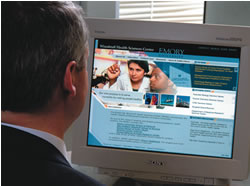

Change of address
An organization's website is its worldwide, round-the-clock, calling card. Now the Woodruff Health Sciences Center (WHSC) has fine-tuned its calling card to better highlight its broad reach and many achievements. At the WHSC website's new address - whsc.emory.edu - you'll find a clear picture of the WHSC's scope as the umbrella organization for all the health sciences at Emory, says Ron Sauder, director of media relations. Sauder worked with a team of staff and consultants to complete the face-lift over the past year.
"Our new look makes much more extensive use of photographs, both people and places, so that a visitor to the website can tour the full spectrum of health sciences at Emory -- from Grady and Emory Crawford Long hospitals to each of the three schools and the Vaccine Center at Yerkes. We also have photos and bios for all of the officers of the Woodruff Health Sciences Center, helping humanize an entity that is pretty abstract to many people. We continue to enhance this personal experience with more photographs and content weekly."
The site explains the history, leadership, and statistical profile of the WHSC and includes sections on education, patient care, and research. On the home page, you'll find recent news, articles from health sciences publications, and upcoming special events. All blurbs link to more information inside the website. Like the old site, the new site functions as a front door to the websites of the schools of medicine, nursing, and public health, as well as Yerkes. It also has multiple links to Emory Healthcare (www.emoryhealthcare.org) but does not attempt to duplicate the patient information and clinical support found there.
In addition to a "slide show," which introduces the WHSC, the site uses interactive technology with preloaded Yahoo and Mapquest maps (under "About Us") and CNN.com, Google, and Yahoo search engines for an "Emory in the News" feature. Original WHSC pages - apart from the deep archives of past news releases and publications - have roughly tripled, from 50 to 150. You can also view video news releases about some of Emory's clinical and research programs.
Send comments or suggestions to rsauder@emory.edu.

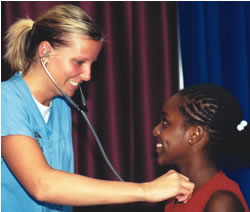
Nursing student Erin Ruel conducted physical exams in the British Virgin Islands, where there's a critical nursing shortage.


High stakes for children, nurses
A dozen Emory nursing students spent spring break in the British Virgin Islands (BVI) in March but not to work on their tans. The students provided physical examinations for nearly 400 schoolchildren, a task traditionally done by physicians.
"This was the first time that nurses there were allowed to do physical assessments. We established a new practice model for nurses and sent a message to the children's teachers and parents about what nurses can do," says Ann Connor, one of two faculty from the Nell Hodgson Woodruff School of Nursing who accompanied the undergraduate and graduate students. The BVI experience resulted from the school's partnerships with nursing leaders throughout the Caribbean, a relationship that has soared since the school's first Global Nursing Partnerships Conference in 2001. There, chief nursing officers from more than 60 countries heard about the alarming number of nurses who were leaving the Caribbean for better pay and working conditions in the United States, Canada, and Great Britain, resulting in a critical workforce shortage at home. That, along with challenges of dealing with HIV/AIDS and a faltering economy, put the region on the verge of disaster.
Since that conference, faculty, staff, and students in the Lillian Carter Center for International Nursing have worked behind the scenes with Caribbean nursing leaders and government officials to help recruit and retain nurses in the region. The Caribbean campaign uses TV commercials, video, and posters produced by Johnson & Johnson to encourage young people to go to nursing school, become nurses, and stay in their countries to work.
The Lillian Carter Center has focused on education as well by recruiting students from the Caribbean, with the understanding they will return home to work after earning their degrees, and by placing Emory nursing students there to work and learn. Students in the BVI gained hands-on nursing experience in a culture where faith plays a strong role in health, education, and daily life. The connection between faith and health lies at the heart of the Hubert Fellowship Program, an initiative based in the Lillian Carter Center and funded by the O.C. Hubert Charitable Trust.
While the students who traveled to the BVI received course credit, other students used their spring break to volunteer with faith groups in Jamaica and the Bahamas. All 14 volunteers are Hubert fellows, students with a special interest in exploring international health and working with vulnerable populations. The Hubert Fellowship Program is a major step toward forming a dual-degree graduate program in nursing and faith with the Candler School of Theology.



No more standing room only
Transplantation requires a lifetime commitment from patients, who need ongoing care and evaluation, and from transplant centers, which have to provide those services. Emory performs about 60% of all organ transplants in Georgia, and the outpatient clinic at Emory University Hospital (EUH) receives more than 15,000 patient visits a year.
While the number of patient visits has grown exponentially since 2000, clinic space hasn't kept pace. Sometimes, in fact, there's standing room only.
That's soon to change. A $1.8 million gift from the Carlos and Marguerite Mason Trust will be used to double existing space at EUH for outpatient transplant care and evaluation. The new interdisciplinary Mason Transplant Outpatient Clinic will provide patients with team-oriented care and treatment from nephrologists, hepatologists, surgeons, cardiologists, dermatologists, psychiatrists, infectious disease specialists, nurse coordinators, patient educators, social workers, and nutritionists.
The project will allow for additional patient exam rooms, consultation rooms, a dedicated patient classroom and resource library as well as increased space for infusion treatment room capacity. The new space is expected to be completed in spring 2005.
"The Mason transplant clinic will allow us to evaluate all our patients in an outpatient setting, provide critical education to patients and families, and deliver quality follow-up care," says Christian Larsen, director of the Emory Transplant Center.

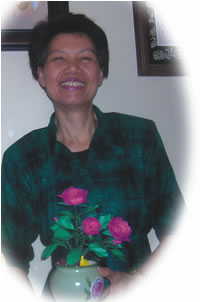

In this issue
From the CEO / LettersHeart and soul
Good bone structure
Big Idea: The code breakers
Moving forward
Noteworthy
On Point:
Insuring America's health

Fighting Parkinson's with origami
Even though Parkinson's disease has made it difficult for Kim Nichols to use her hands and to walk, she's still able to make the intricate folds that create beautiful origami paper flowers - lilies, roses, cornflowers, irises, and more - which she fashions into arrangements. All proceeds from the sale of Nichols' arrangements support Parkinson's disease research in the Emory Center for Neurodegenerative Disease.
A resident of Warner Robins, Nichols is a seven-year employee of the Northrop Grumman Corporation's logistics services division. She does electronic wire soldering, building electronic circuit boards -- all requiring intense hand work. Her right hand is particularly impaired, so she's learned to depend on her left one.
Nichols was diagnosed with Parkinson's two years ago. She began her personal crusade as a way to combat her severe depression following the diagnosis. Not wanting to ask people for contributions, she surveyed her skills. She has done origami, the Japanese art of folding paper into decorative birds, animals, and other forms, since she was a small child in Taiwan. "I don't ask people to donate money; I ask them to buy a flower. That way they have something." Each arrangement takes about 30 hours to make and are for sale on her web site, http://members.cox.net/kimn105.
Last year alone, she raised $6,276, but the flowers are not Nichols' only fund-raising initiative. Among other efforts, she's also prepared a pancake breakfast at the Northrop Grumman plant, cooked 180 orders of fried rice that she sold at lunch, and auctioned off a Thanksgiving basket loaded with items donated by fellow employees.
"Kim's efforts really show what a difference one person can make," says Mahlon DeLong, her neurologist at Emory.
Nichols urges other Parkinson's patients to support research. "If it doesn't help you, it will help somebody else. If not now, for future generations."
Copyright © Emory University, 2004. All Rights Reserved.
Send comments to the Editors.
Web version by Jaime Henriquez.